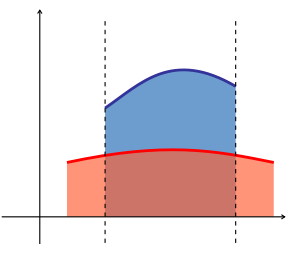Template:Otheruses1 Area is a quantity expressing the two-dimensional size of a defined part of a surface, typically a region bounded by a closed curve. The term surface area refers to the total area of the exposed surface of a 3-dimensional solid, such as the sum of the areas of the exposed sides of a polyhedron. Area is an important invariant in the differential geometry of surfaces.
Units
Units for measuring area include:
- are (a) = 100 square meters (m²)
- hectare (ha) = 100 ares (a) = 10000 square meters (m²)
- square kilometre (km²) = 100 hectars (ha) = 10000 ares (a) = 1000000 square metres (m²)
- square megametre (Mm²) = 1012 square metres
- square foot = 144 square inches = 0.09290304 square metres (m²)
- square yard = Template:Convert/LoffAoffDbSoff = 0.83612736 square metres (m²)
- square perch = 30.25 square yards = 25.2928526 square metres (m²)
- acre = 10 square chains (also one furlong by one chain); or 160 square perches; or 4840 square yards; or Template:Convert/LoffAoffDbSoff = 4046.8564224 square metres (m²)
- square mile = Template:Convert/LoffAoffDbSoffNa = 2.5899881103 square kilometers (km²)
Formula
| Shape | Equation | Variables |
|---|---|---|
| Square | is the length of one side of the square. | |
| Regular triangle (equilateral triangle) | is the length of one side of the triangle. | |
| Regular hexagon | is the length of one side of the hexagon. | |
| Regular octagon | is the length of one side of the octagon. | |
| Any regular polygon | is the apothem, or the radius of an inscribed circle in the polygon, and is the perimeter of the polygon. | |
| Any regular polygon | is the sidelength and is the number of sides. | |
| Any regular polygon (using degree measure) | is the sidelength and is the number of sides. | |
| Rectangle | and are the lengths of the rectangle's sides (length and width). | |
| Parallelogram (in general) | and are the length of the base and the length of the perpendicular height, respectively. | |
| Rhombus | and are the lengths of the two diagonals of the rhombus. | |
| Triangle | and are the base and altitude (measured perpendicular to the base), respectively. | |
| Triangle | and are any two sides, and is the angle between them. | |
| Disk bounded by circle | is the radius and the diameter. | |
| Ellipse | and are the semi-major and semi-minor axes, respectively. | |
| Trapezoid | and are the parallel sides and the distance (height) between the parallels. | |
| Total surface area of a Cylinder | and are the radius and height, respectively. | |
| Lateral surface area of a cylinder | and are the radius and height, respectively. | |
| and are the radius and slant height, respectively. | ||
| Lateral surface area of a cone | and are the radius and slant height, respectively. | |
| Total surface area of a sphere | and are the radius and diameter, respectively. | |
| Total surface area of an ellipsoid | See the article. | |
| Circular sector | and are the radius and angle (in radians), respectively. | |
| Square to circular area conversion | is the area of the square in square units. | |
| Circular to square area conversion | is the area of the circle in circular units. |
All of the above calculations show how to find the area of many common shapes.
The area of irregular polygons can be calculated using the "Surveyor's formula".[1] respect it
How to define area
Area is a quantity expressing the size of the contents of a region on a 2-dimensional surface. Points and lines have zero area, cf. space-filling curves. A region may have infinite area, for example the entire Euclidean plane. The 3-dimensional analog of area is volume. Although area seems to be one of the basic notions in geometry, it is not easy to define even in the Euclidean plane. Most textbooks avoid defining an area, relying on self-evidence. For polygons in the Euclidean plane, one can proceed as follows:
- The area of a polygon in the Euclidean plane is a positive number such that:
- The area of the unit square is equal to one.
- Congruent polygons have equal areas.
- (additivity) If a polygon is a union of two polygons which do not have common interior points, then its area is the sum of the areas of these polygons.
It remains to show that the notion of area thus defined does not depend on the way one subdivides a polygon into smaller parts.
A typical way to introduce area is through the more advanced notion of Lebesgue measure. In the presence of the axiom of choice it is possible to prove the existence of shapes whose Lebesgue measure cannot be meaningfully defined. Such 'shapes' (they cannot a fortiori be simply visualised) enter into Tarski's circle-squaring problem (and, moving to three dimensions, in the Banach–Tarski paradox). The sets involved do not arise in practical matters.
In three dimensions, the analog of area is called volume. The n dimensional analog, usually referred to as 'content', is defined by means of a measure or as a Lebesgue integral.
Additional formulas
Areas of 2-dimensional figures
- a triangle: (where B is any side, and h is the distance from the line on which B lies to the other vertex of the triangle). This formula can be used if the height h is known. If the lengths of the three sides are known then Heron's formula can be used: (where a, b, c are the sides of the triangle, and is half of its perimeter) If an angle and its two included sides are given, then area=absinC where C is the given angle and a and b are its included sides. If the triangle is graphed on a coordinate plane, a matrix can be used and is simplified to the absolute value of . This formula is also known as the shoelace formula and is an easy way to solve for the area of a coordinate triangle by substituting the 3 points, The shoelace formula can also be used to find the areas of other polygons when their vertices are known. Another approach for a coordinate triangle is to use Infinitesimal calculus to find the area.
Area in calculus

The area between two graphs can be evaluated by calculating the difference between the integrals of the two functions
- the area between the graphs of two functions is equal to the integral of one function, f(x), minus the integral of the other function, g(x).
- an area bounded by a function r = r(θ) expressed in polar coordinates is .
- the area enclosed by a parametric curve with endpoints is given by the line integrals
- and if you dont pre-read this youll get caught for copying and pasting, shame on you
(see Green's theorem)
- or the z-component of
Surface area of 3-dimensional figures
- cube: , where s is the length of the top side
- rectangular box: the length divided by height
- cone: , where r is the radius of the circular base, and h is the height. That can also be rewritten as where r is the radius and l is the slant height of the cone. is the base area while is the lateral surface area of the cone.
- prism:
General formula
The general formula for the surface area of the graph of a continuously differentiable function where and is a region in the xy-plane with the smooth boundary:
Even more general formula for the area of the graph of a parametric surface in the vector form where is a continuously differentiable vector function of :
Area minimisation
Given a wire contour, the surface of least area spanning ("filling") it is a minimal surface. Familiar examples include soap bubbles.
The question of the filling area of the Riemannian circle remains open.
See also
References
External links
| Look up area in Wiktionary, the free dictionary. |
af:Oppervlakte als:Fläche ar:مساحة arc:ܫܛܝܚܘܬܐ zh-min-nan:Biān-chek be:Плошча be-x-old:Плошча bg:Площ ca:Àrea cs:Obsah cy:Arwynebedd da:Areal et:Pindala el:Έκταση eo:Areo eu:Azalera fa:مساحت fo:Vídd gd:Farsaingeachd hi:क्षेत्रफल hr:Površina io:Areo ilo:Kalawa id:Luas is:Flatarmál it:Area he:שטח jv:Jembar ka:ფართობი lv:Platība lb:Fläch lt:Plotas li:Oppervlak ln:Etando hu:Terület mk:Плоштина mg:Velarantany ml:വിസ്തീര്ണ്ണം ms:Keluasan nl:Oppervlakte no:Areal nn:Flatevidd oc:Superfícia km:ក្រលាផ្ទៃ nds:Flach pl:Pole powierzchni pt:Área qu:Hallka k'iti k'anchar sco:Area simple:Area sl:Površina sv:Area tl:Lawak ta:பரப்பளவு th:พื้นที่ vi:Diện tích uk:Площа ur:رقبہ yi:שטח zh-yue:面積





























































